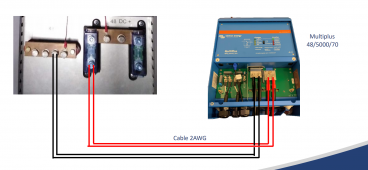It also says the Pylontech battery cables are rated for 120A. Does that mean the inverter should be programmed to only discharge battery bank at a maximum of 120A? Or is it ok to allow a higher discharge rate, since I'm using 2 sets of cables as shown below?
The document said the max charge/discharge rate is 74A. Don’t exceed that.
Pulling from two cables, you could get up to 120A x 2 = 240A, if current splits evenly.
A fuse on each cable would protect in case 120A was exceeded.
It won't exactly balance, of course, so after measuring imbalance you could program a max draw with further margin below 240A to ensure no fuses blown. Remember continuous draw through a thermal fuse or breaker shouldn't exceed 80% of rating. I read that magnetic/hydraulic can be used up to 100%.
If each battery's BMS protects against continuous draw over 74A, that is probably sufficient for enforcing its limit. keep system maximum current low enough to avoid tripping BMS. The split probably varies as each battery passes through knee of charge curve. If you are able to log all readings while draining at moderately heavy current, that should help determine max that can be drawn at any SoC. I would guess it also depends on SoC differences driven by previous recharge current and voltage.
Connecting four batteries in parallel and tapping the ends will be less perfect balancing of current draw. More important for lead-acid which you would want to recharge equally. For Lithium, impact will be on maximum current that bank can produce.
Two batteries in parallel, another two batteries in parallel, those two pairs paralleled by diagonally opposite corners. That pack of four connected by diagonally opposite corners (in your case, maybe two pairs of cables each tapping a different diagonally opposite pair of corners. Confirm this results in every battery seeing same resistance, and cables carrying 1x, 2x, 4x battery current have a twin on the other polarity circuit.)








